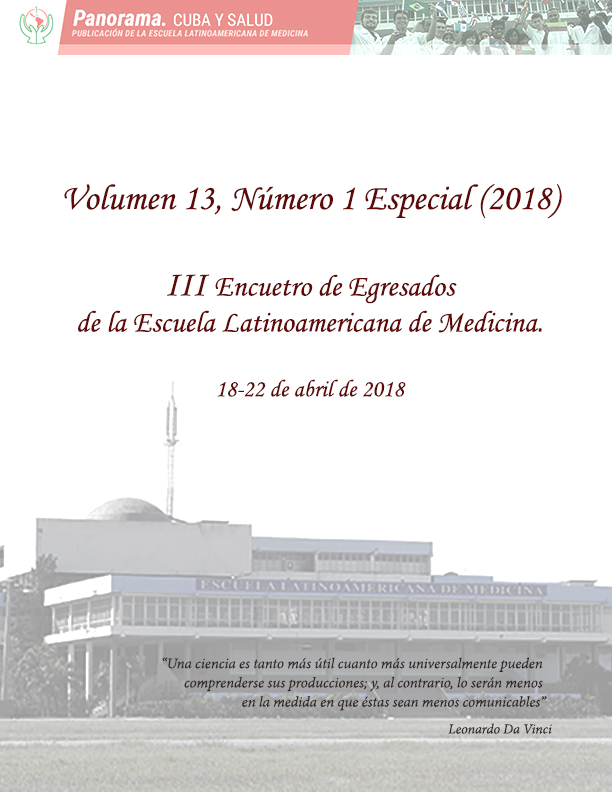Agregación familiar en niños con hipertensión arterial esencial/Family aggregation in children with essential hypertension
Palabras clave:
hipertensión arterial, agregación familiar, herencia multifactorial/hipertensión arterial, herencia multifactorial/arterial hypertension, family aggregation, multifa.Resumen
RESUMEN
Objetivo: identificar la influencia de los factores genéticos en la aparición de la hipertensión arterial esencial en niños.
Materiales y Métodos: se realizó un estudio de casos y controles retrospectivo en pacientes pediátricos atendidos en el Hospital Naval de La Habana, desde enero de 2015 hasta septiembre de 2016; la muestra incluyó 45 casos y 90 controles para evaluar asociación entre diferentes variables cualitativas.
Resultados: la hipertensión arterial esencial predominó en el grupo de 11 a 18 años (88,4%) y sexo masculino (75,6%), la obesidad y el sobrepeso estuvo presente en el 84,4% de los hipertensos, la agregación familiar se evidenció, cuando las madres presentaron hipertensión durante el embarazo pues sus hijos tuvieron una mayor probabilidad de padecer hipertensión (Odds ratio 4,16), si el padre era hipertenso el riesgo fue (OR 2,19), siendo también significativo; en la segunda generación se demostró la agregación familiar en los abuelos maternos (OR 2,19) y paternos (OR 3,23) de que sus nietos fueran hipertensos. En este estudio, la línea parental paterna tuvo una mayor relación con la agregación familiar y la probabilidad de aparición de hipertensión arterial esencial.
Conclusiones: la agregación familiar y el grado de parentesco son factores genéticos que influyen en la aparición de estanenfermedad en las edades pediátricas, lo que demuestra la herencia de genes predisponentes.
ABSTRACT
Objective: to identify the influence of genetic factors on the appearance of essential hypertension in children.
Materials and Methods: a retrospective case-control study was conducted in pediatric patients treated at the Naval Hospital of Havana, from January 2015 to September 2016; The sample included 45 cases and 90 controls to evaluate the association between different qualitative variables.
Results: the essential arterial hypertension prevailed in the group of 11 to 18 years (88.4%) and male sex (75.6%), obesity and overweight were present in 84.4% of the hypertensive patients, the aggregation family was evident, when mothers had hypertension during pregnancy because their children were more likely to suffer hypertension (Odds ratio 4,16), if the father was hypertensive the risk was (OR 2.19), being also significant; in the second generation, family aggregation was demonstrated in maternal (OR 2.19) and paternal (OR 3.23) grandparents that their grandchildren were hypertensive. In this study, the paternal parental line had a greater relationship with family aggregation and the probability of the appearance of essential hypertension.
Conclusions: family aggregation and degree of kinship are genetic factors that influence the appearance of this disease in pediatric ages, which demonstrates the inheritance of predisposing genes.
Descargas
Publicado
Cómo citar
Número
Sección
Licencia
La aceptación de un trabajo para su publicación en Panorama. Cuba y Salud supone que Los autores/as conservarán sus derechos de autor y garantizarán a la revista el derecho de primera publicación de su obra, el cual estará simultáneamente sujeto a la Licencia de reconocimiento de Creative Commons que permite a terceros compartir la obra siempre que se indique su autor y su primera publicación esta revista.
Los autores/as podrán adoptar otros acuerdos de licencia no exclusiva de distribución de la versión de la obra publicada, siempre que se indique la publicación inicial en esta revista.
Licencia Creative Commons
La Revista Panorama Cuba y Salud se encuentra bajo una
Licencia Creative Commons Reconocimiento-NoComercial 4.0






